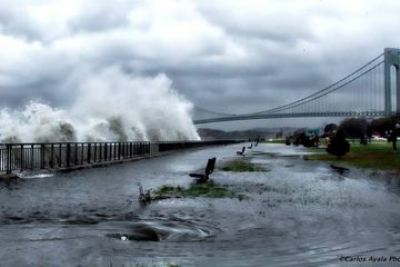How to Stay Wired: Powering Through Natural Disasters, Sandy or Otherwise
By Jotham Sederstrom July 19, 2013 8:00 am
reprintsBeing down as the result of a natural disaster, flood or fire is always a major catastrophe for commercial buildings. Aside from simply switching to fiber cables, which are naturally more resilient, here are several ways to increase your chances of staying fully operational when you’re hit hard by one of the elements.
One of the biggest trends quickly gaining momentum: put it all in the cloud.
 Known formally as “online services” or “virtual data-storing centers,” cloud-based services allow you to work from home or any other location that’s still connected. Most small businesses use Dropbox for Business, which costs $795 a year for five users and up to $12,670 a year for 100 users. Alternatives to DropBox include iCloud, Flickr, Amazon, Rackspace, Microsoft and Google.
Known formally as “online services” or “virtual data-storing centers,” cloud-based services allow you to work from home or any other location that’s still connected. Most small businesses use Dropbox for Business, which costs $795 a year for five users and up to $12,670 a year for 100 users. Alternatives to DropBox include iCloud, Flickr, Amazon, Rackspace, Microsoft and Google.
“Businesses that use the cloud have adapted to the point where they don’t really care if the office is closed,” said Rafi Kronzon, CEO of Cartwheel, an IT services company. “Our office is on the 18th floor, and we were without power for a week, but it didn’t matter at all. We were 100 percent functioning.”
Then there’s the “redundancy” strategy, which is exactly what it sounds like: have two service providers.
“If all of your service comes from one main control center, and they’re down, you’re done,” said Pete Giampietro, owner and vice president of consulting company Teleplan Associates Inc. “Split the service coming into the building. Even if you have a fire or water damage, you wouldn’t lose more than half of your service.”
Also, he says, one of the biggest disasters can be people, not storms.
“If you have contractors working in the street, when they’re digging, they’ll dig up the conduits where the cables are and throw the building out of service,” said Mr. Giampietro. “If you only have one conduit entrance and it gets damaged, you’ll lose everything. Since cables can’t come under the ground, landlords should have an alternate entrance for them.”
Additionally, each carrier should have its own room in the building, because then each have more control over its own facilities, and each building should have an alternate “riser” (the conduit that comes into a building), so that even if one side of the building is out, you’ve still got the other.
It’s also important to make sure that all of your telecom equipment in basements and closets is labeled properly. If it isn’t, you’ll have delays in service delivery, because everything needs to be verified before your provider turns it back on. In addition, if a tenant or the landlord has a service outage or repair problem, repair times could go from hours to days, becoming what Mr. Giampietro describes as “a nightmare” that he’s personally lived through.
While the suggestion to simply move your generators and switchboards from the basement to a room above ground may seem like the perfect solution, many landlords may not want to.
“Landlords want to rent out as much square footage as they can. If every building has to move equipment out of the basement and onto second floor, that eats up really valuable real estate, and that’s a problem a lot of building owners are not willing to have,” said Morris Tabush, founder and principal of Tabush Managed IT Service Providers. “You’d have to forfeit a few thousand square feet of otherwise rentable space, and then Verizon, ConEd, etc., could come in and charge $1 million to rewire.”
Depending on the size of your company and the deal you’re able to strike with various providers, it may or may not be worth opting for these better-safe-than-sorry alternatives. Be sure to weigh the pros, cons and odds before taking your chances.


